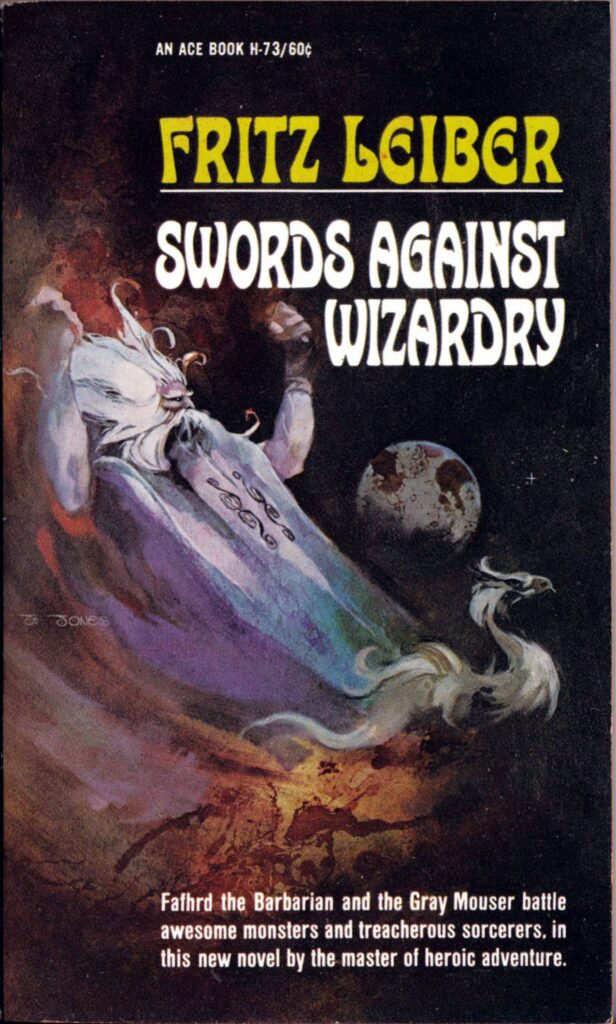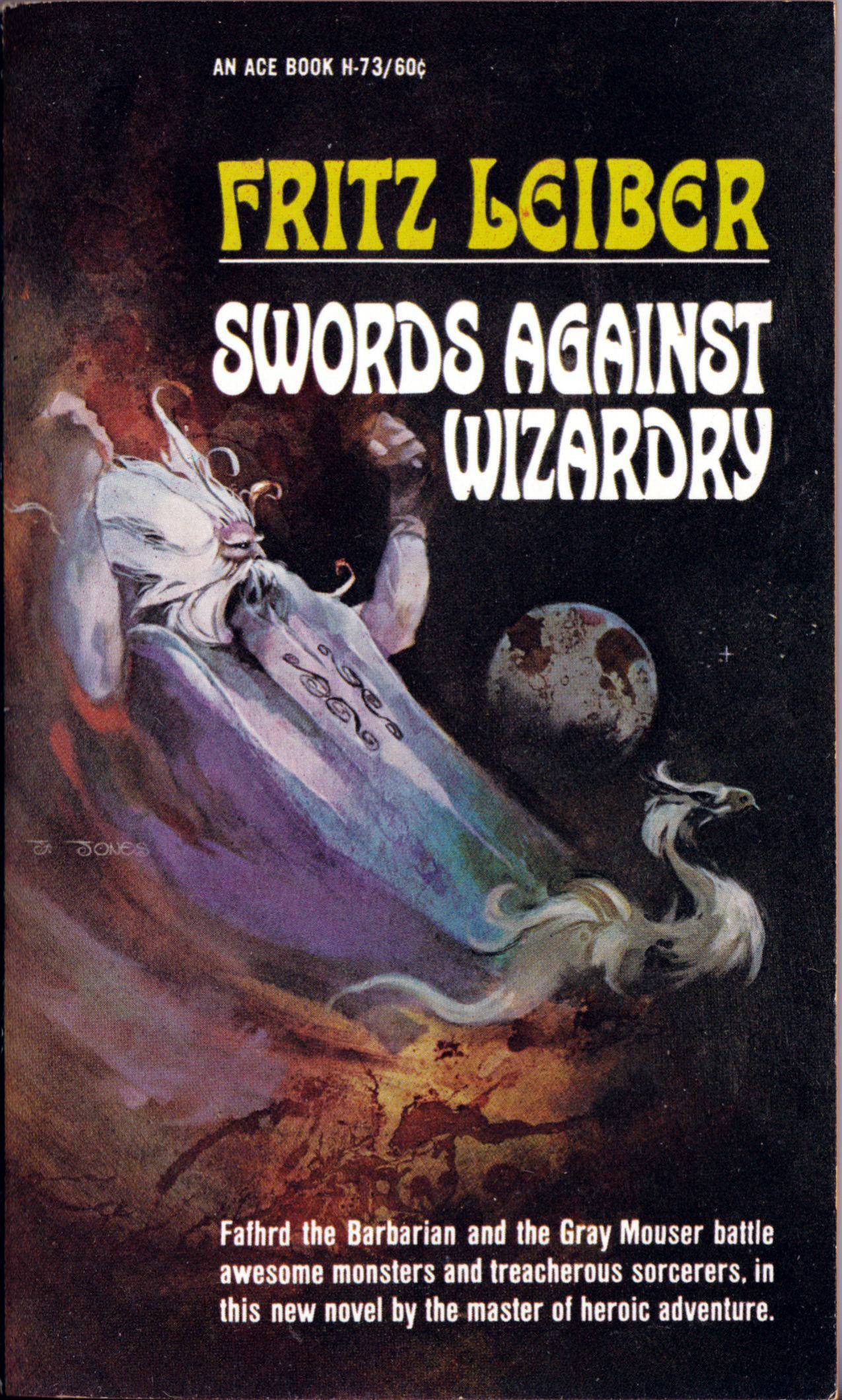Book Review: Swords Against Wizardry by Fritz Leiber
We return, gentle readers, to the fabled world of Nehwon, home of those bold rogues, Fafhrd and the Gray Mouser. But they are not in their favorite city, Lankhmar, but in Fafhrd’s home territory of the Cold Wastes to the north. For they have learned of fabled treasure atop the mountain Stardock, and what thief can resist the lure of treasure?

This “novel” was stitched together from a prologue, two novellas and a linking short story that originally appeared in Fantastic magazine. After receiving part of a prophecy about their upcoming venture from a rudely interrupted witch, our protagonists have to book it out of town without the crucial final line.
Stardock is apparently the highest mountain on Nehwon, and supposedly has never been scaled by mortal men. So how does anyone know there’s treasure up there? A very good question, which does get answered by the end. Fafhrd, who spent a few years of his childhood in the area, is familiar with the first part of the ascent. This gives him and the Mouser an initial competitive advantage against a rival pair of mountain climbers.
Much of this section is a fairly realistic depiction of mountain climbing, with Mr. Leiber crediting Poul Anderson and Paul Turner for information on that subject. This is interspersed with more fantastic dangers, as there are monsters and invisible beings inhabiting the thin-aired heights. The last stretch is almost entirely fantasy, but it turns out there’s more than one kind of treasure to be had.
Back in Lankhmar, our protagonists try to parlay their remaining treasure into riches, but a conjuncture of sexism and horniness leaves them open to even more clever thieves. Broke now, and needing some space from each other, Fafhrd and the Gray Mouser separately accept bodyguard assignments from rival princes. (A Joanna Russ character has a blink and you’ll miss it cameo.)
The remainder of the book takes place in the mostly underground kingdom of Quarmall. This setting was created by Harry Otto Fischer, who contributed some 10,000 words of descriptive text that Mr. Leiber inserted the plot around.
Quarmall is one of those kingdoms that used to be a major empire in times long past, but got pushed back and back and back until its remaining people dug under the castle at its center as a defense against enemies and over the course of centuries moved permanently into their underground labyrinth. King Quarmal (note the different spelling) is very old and his two sons hate both him and each other.
Prince Hasjarl of the Upper Levels, a physically twisted and ill-tempered fellow, has hired Fafhrd as his sworder, to protect him from the swordsman his brother has supposedly hired. Fafhrd mislikes Hasjarl’s favorite activity of torturing people.
Prince Gwaay of the Lower Levels is a more handsome fellow, if you like them pale and slim, and prides himself on emotional self-control. His favorite game involves moving bits of volcanic rock around a board with his mind. But make no mistake, he’s as murderous as his brother. He’s hired the Gray Mouser as his sworder to counter the mysterious swordsman Hasjarl is reported to have.
The brothers dare not directly strike at each other until the time is right, and are engaged in indirect warfare, much like a chess game. King Quarmal is disappointed in both of them, but one of the few sacred laws he follows prevents him from killing or ordering the killing of his own sons. Tonight, Quarmal casts his horoscope, predicting the year to come. Surely this is the night things will happen!
It is. There’s some pretty intricate foreshadowing in this part, see if you can spot the relevant clues before they become important. While much of the plotline would have happened without our heroes, they do heavily influence the outcome.
The two major parts nicely contrast Fafhrd and the Mouser working as a team versus them working separately but in parallel. Much of the interest in these stories comes from how they have such contrasting styles and personalities, but also great similarities. The middle part emphasizes that even when they’re sick of each other and can barely stand to be in the same room, they trust each other absolutely.
One of their similarities is that they’re both lusty fellows with a weakness for the ladies. They’re also attractive to women, and often enjoy temporary success. There’s three pairs of beauties in this book, though I must warn you that beauty is subjective.
Nehwon is a rather amoral world, other people’s lives are cheap and few people mourn those they were not close to. Slavery is a fact of life. There are morally gray people like our heroes, and then there are those who are just plain evil.
Content note: Swordplay, often lethal, plus some less savory deaths. In particular, several people are forced to be burned alive. Body horror. Torture has happened off-page. Extramarital sex. Sexism.
This is a fun series with interesting central characters, and this volume takes them from mountaintops to deepest tunnels. These stories have been reprinted several times, so should be easy to find. Recommended to old-school sword and sorcery fans. (At one point a character says, “Now is the time for sorcery and swords!”)

